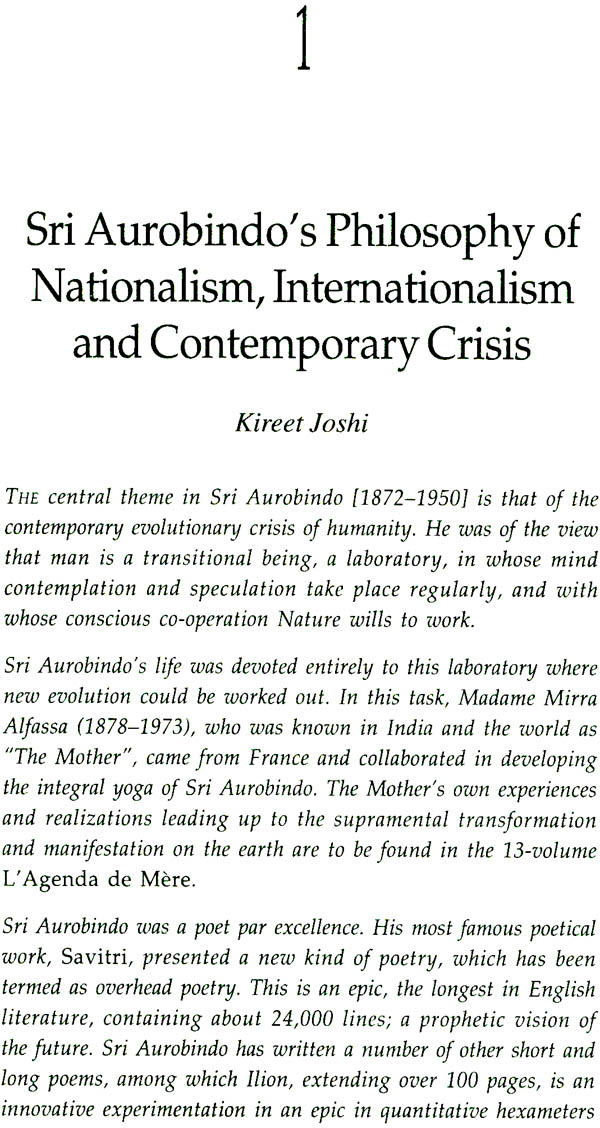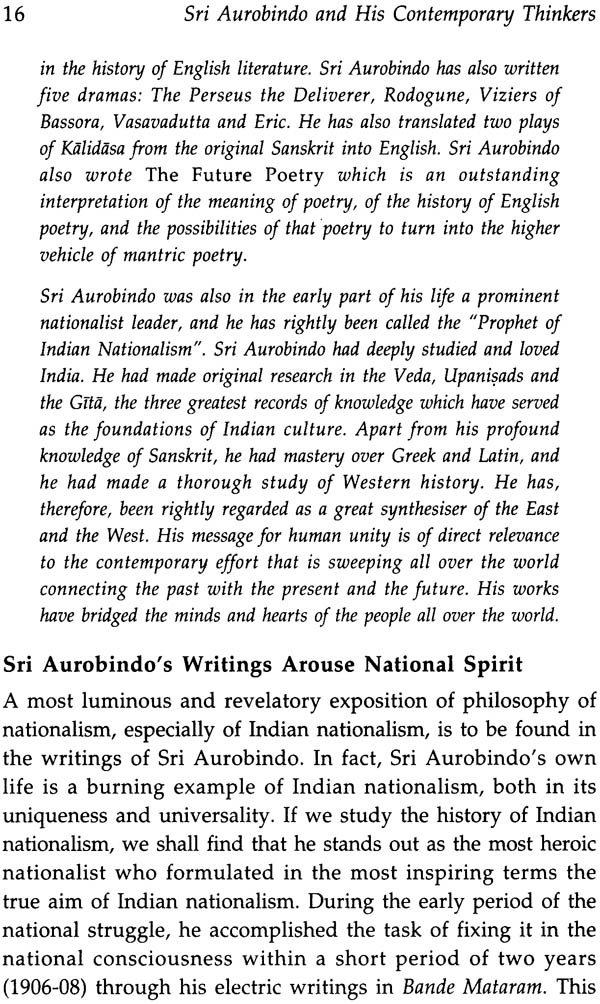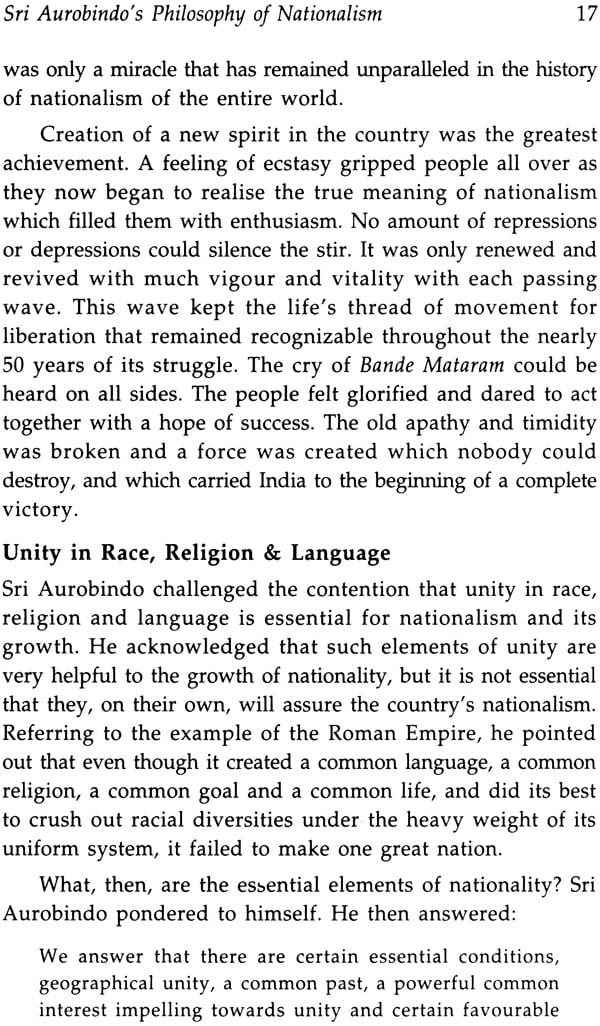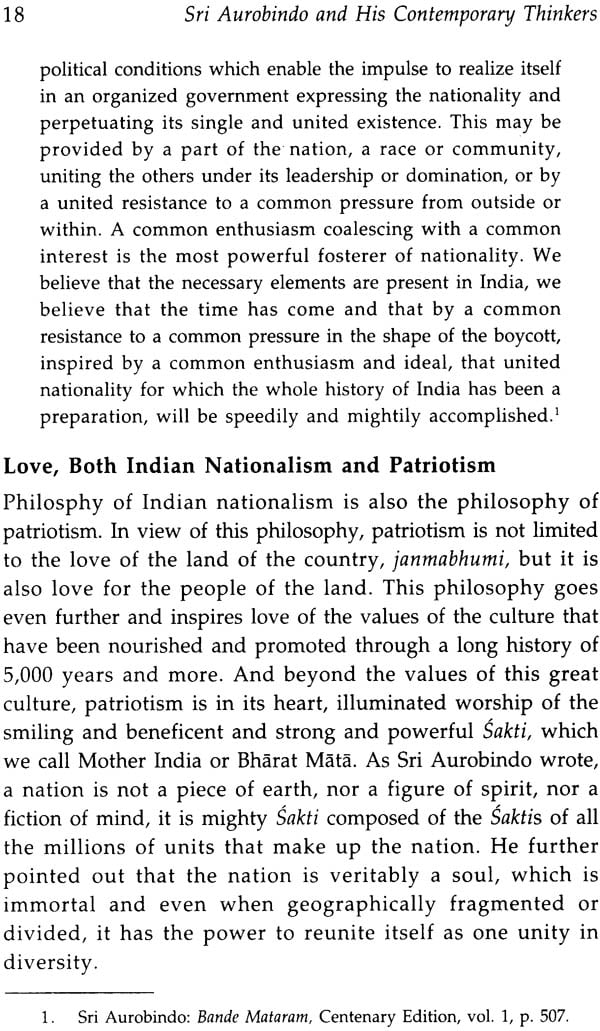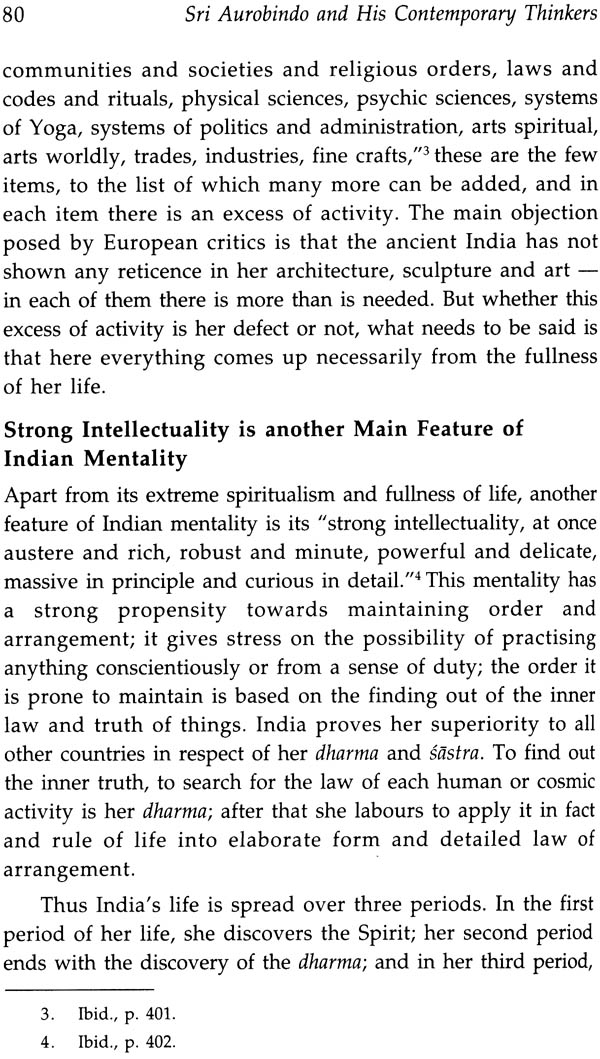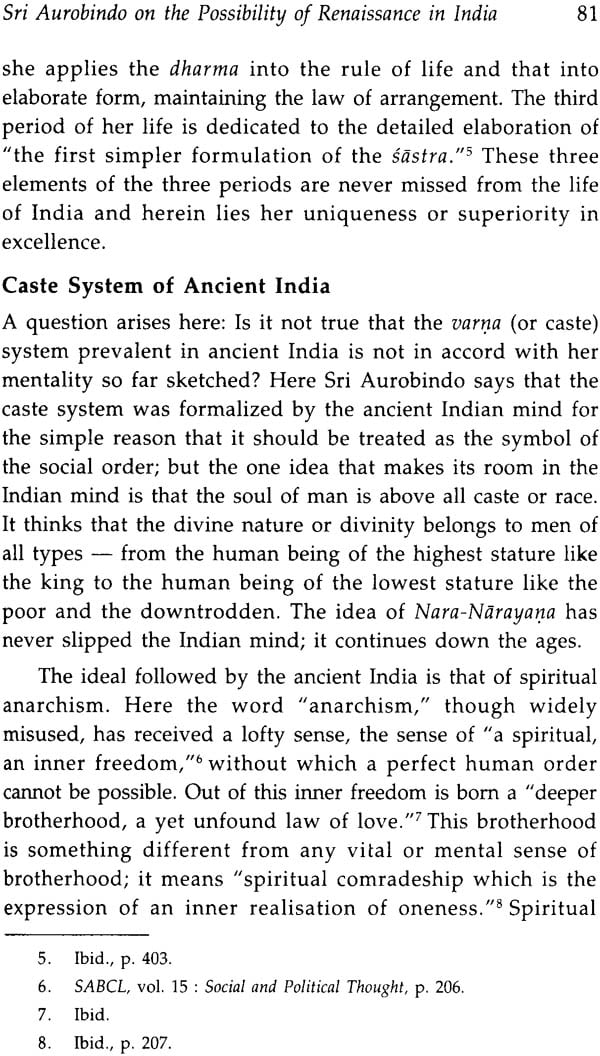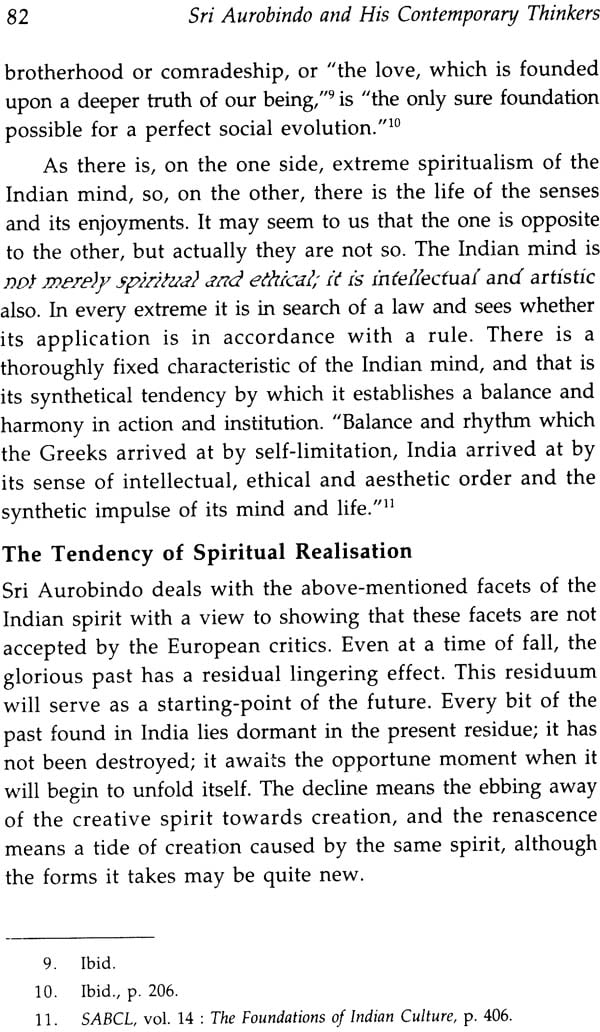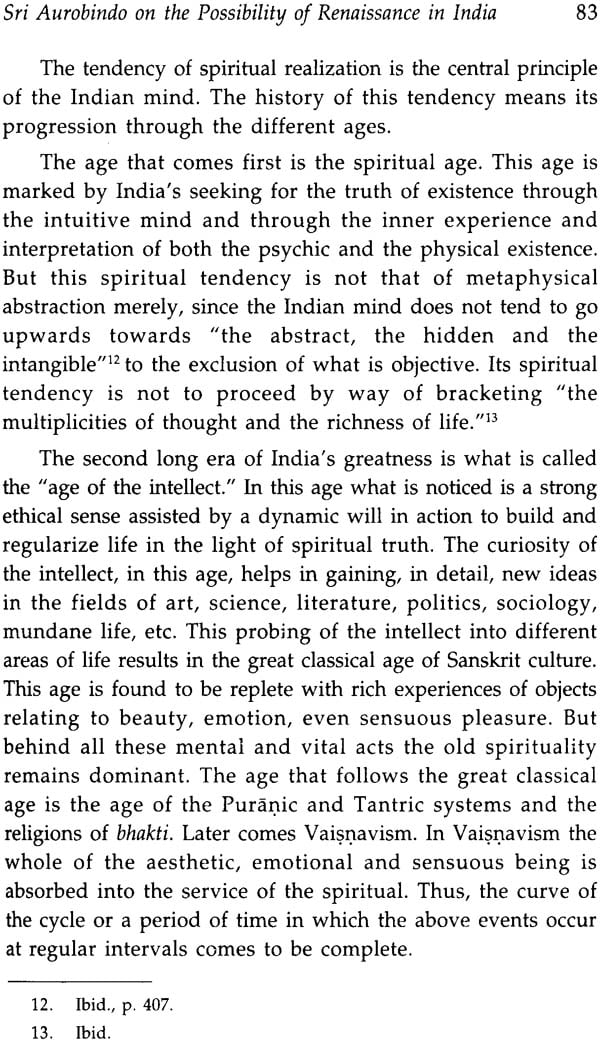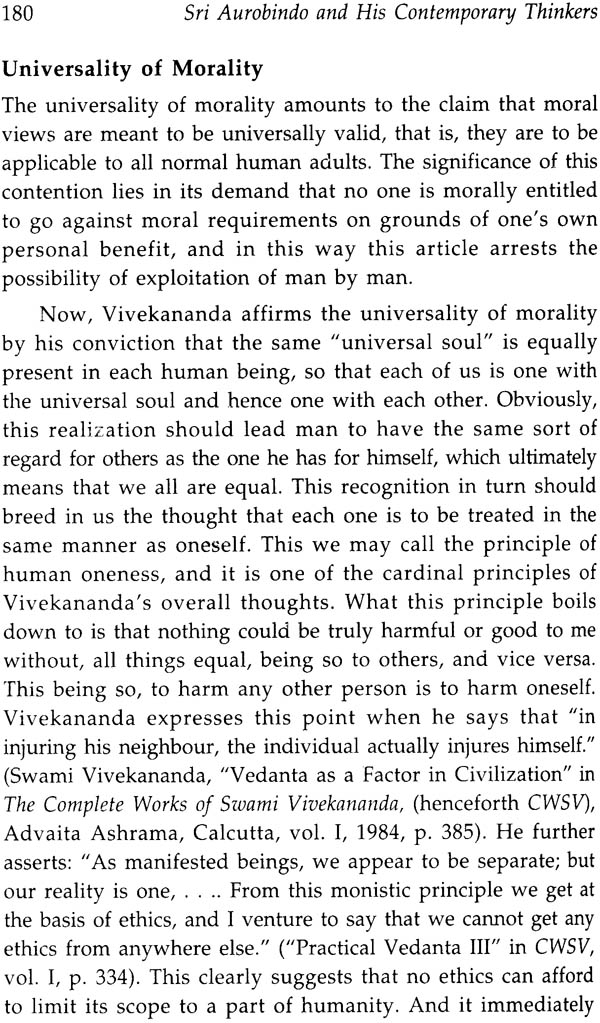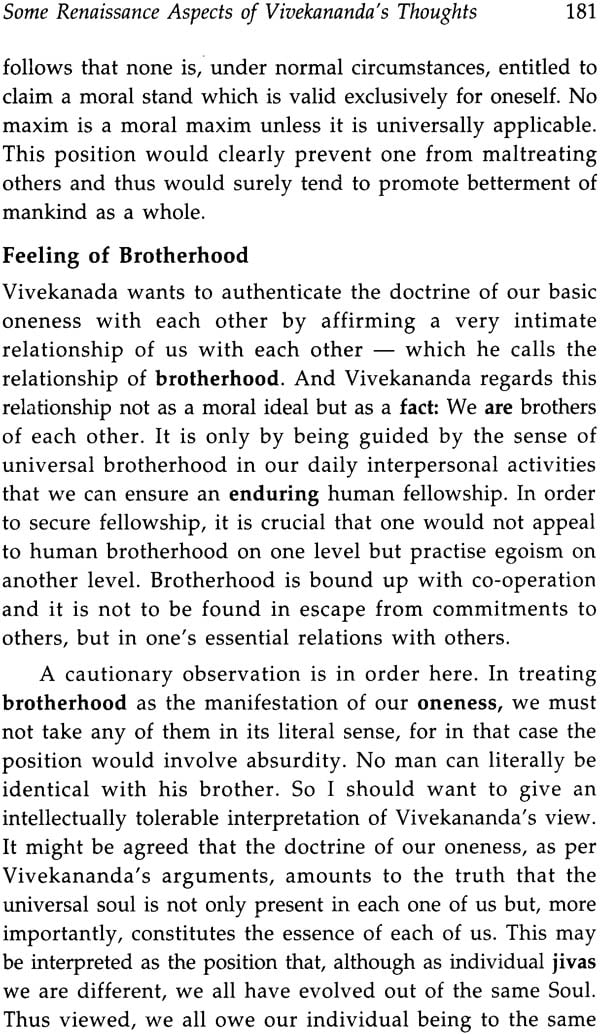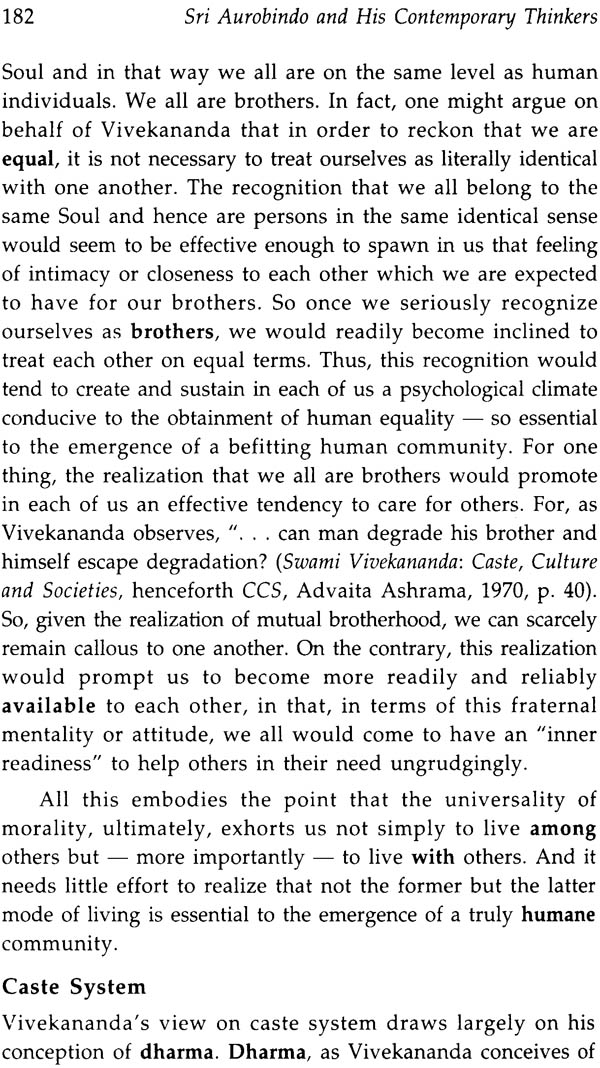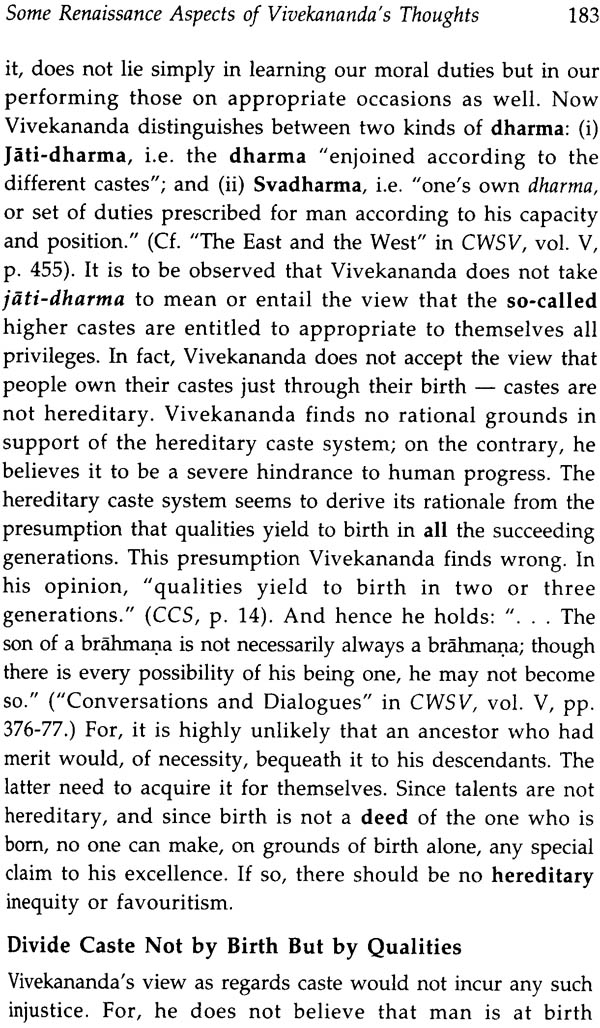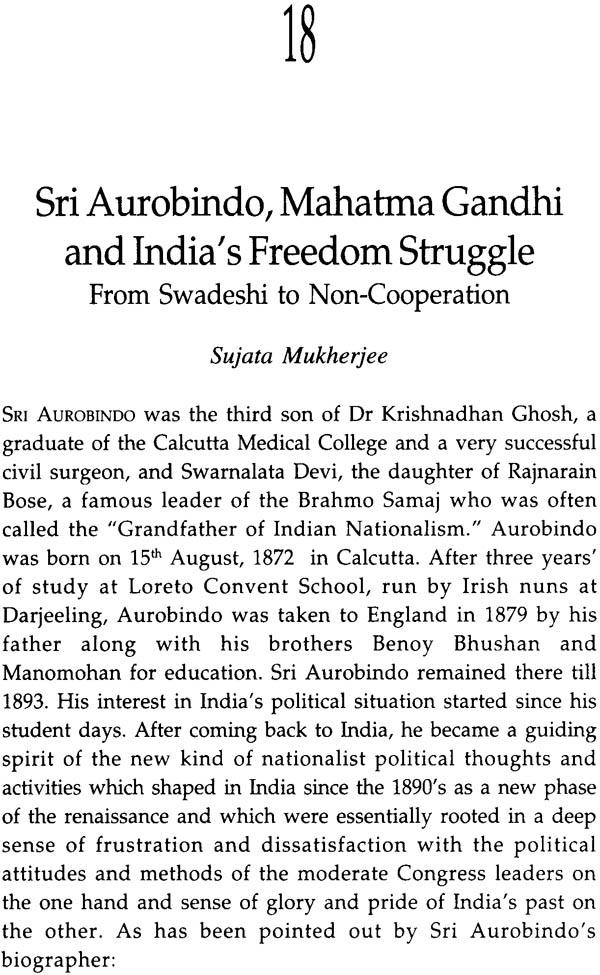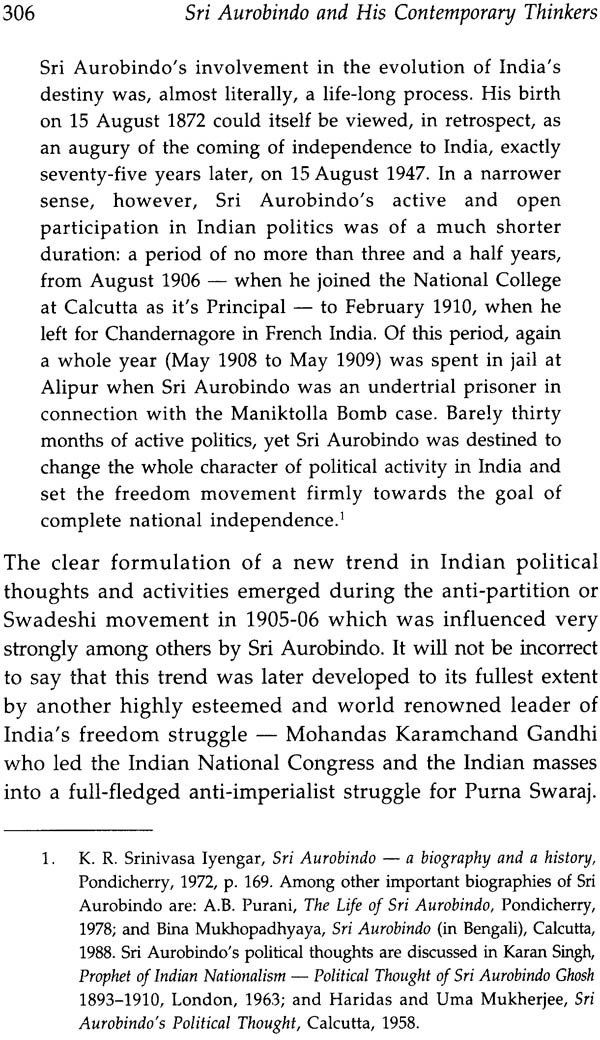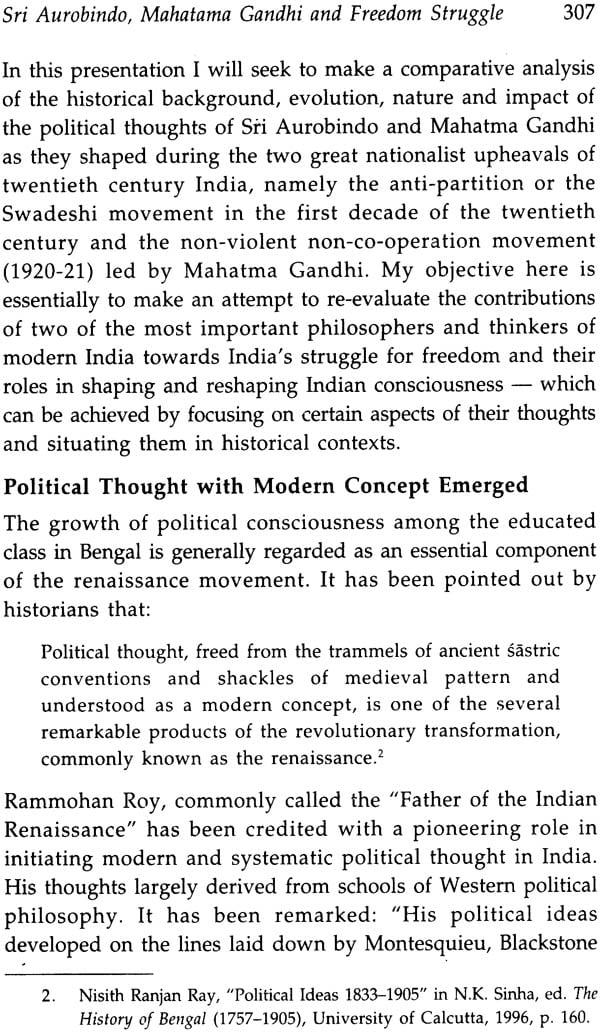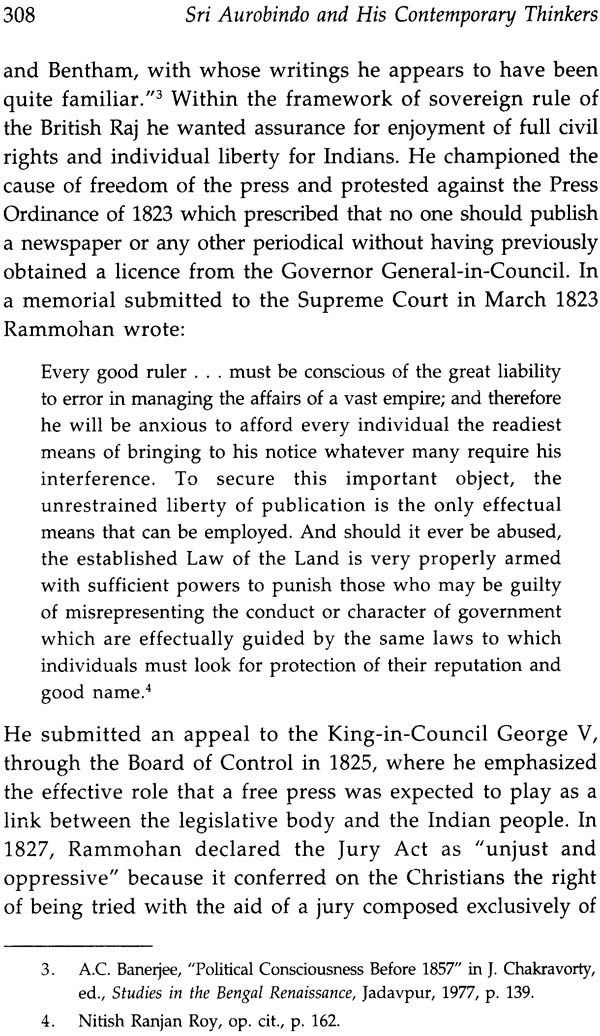
Sri Aurobindo and His Contemporary Thinkers
Book Specification
| Item Code: | IDK208 |
| Author: | Indrani Sanyal &Krishna Roy |
| Publisher: | D. K. Printworld Pvt. Ltd. |
| Language: | English |
| Edition: | 2007 |
| ISBN: | 9788124604281 |
| Pages: | 360 |
| Cover: | Hardcover |
| Other Details | 9.0" X 6.0" |
| Weight | 650 gm |
Book Description
The period spanning the latter half of the eighteenth century and the nineteenth century in India was marked by a reawakened national spirit to reinterpret Indian traditional values I modern light. This book, comprising deliberations presented at a national seminar, discusses some of the illustrious persons of that period who by their ideas and actions enriched the socio-cultural and spiritual life of the period.
Researchers study the period of Sri Aurobindo, his contributions as well as those of his contemporaries including Raja Ram Mohan Roy, Mahatma Gandhi, Tagore, Gokhale and Satish Chandra. The aim is to situate Sri Aurobindo's thought in its socio-cultural background and study the contributions of his contemporaries to bring out the distinctiveness of Sri Aurobindo. The essays deal with Sri Aurobindo's philosophy of nationalism, his view of Indian renaissance and Ireland's national and cultural renaissance and his attitude towards national education. They take up interpretations of violence and nonviolence by Sri Aurobindo and Mahatma Gandhi, Vivekananda's outlook about morality, caste system and dharma, and response of Aurobindo, Tilak and Gokhale to Western imperialism. An interesting effort is made to compare the thoughts of Sri Aurobindo and Tagore towards the revolutionary movement and reveal Aurobindo's perception of Tagore's poetry.
The book will be useful to historians, political and social thinkers, besides the general readers.
Indrani Sanyal is Professor of Philosophy at Centre of Advanced Study in Philosophy and also Co-ordinator, Centre for Sri Aurobindo Studies, Jadavpur University. Her areas of interest include Metaphysics, Philosophy of Language, Ethics, especially Indian Ethics and Philosophy of Sri Aurobindo. Besides publishing many articles in anthologies and journals, she is the author of On Essentialist Claims. She has co-edited Wittgenstein: Jagat, Bhasa O Cintan; Siksaksetre Parasparika Samparka: Understanding Thoughts of Sri Aurobindo; Sruti Bharatiya Dharmanitir Bhittirupe; and other anthologies.
Krishna Roy is a former Professor at Centre of Advanced Study in Philosophy, Jadavpur University, Kolkata. Her areas of interest include Phenomenology, Existentialism, Hermeneutics, Social and Political Philosophy. Besides publishing many articles in various journals, she has published Hermeneutics: East and West, and has edited Fusions of Horizons: Socio Spiritual Heritage of India; and Political Philosophy: East and West. She has co-edited four anthologies: Language, knowledge and Ontology; Essays in Social Political Philosophy; Theory and Practice: A Collection of Essays; and Understanding Thoughts of Sri Aurobindo. At present she is associated with the Research Department of the Centre for Indological Studies at the Ramakrishna Mission Institute of Culture, Kolkata.
In the present anthology, Sri Aurobindo and His Contemporary Thinkers, an inter-disciplinary approach has been taken to bring to light the position and thoughts of Sri Aurobindo and his contemporaries. This anthology includes man of the deliberations that were presented in the national seminar on "Sri Aurobindo and his Contemporary Thinkers" held in 2006, organized by Centre of Sri Aurobindo Studies, Jadavpur University and the other seminar on "Sri Aurobindo and the Indian Renaissance" held in 2007 and organized by Centre for Sri Aurobindo Studies, Jadavpur University in collaboration with Darsan O Samaj Trust, Kolkata. We are very much grateful to Prahlad Kumar Sarkar, the Founder-Director of Darsan O Samaj Trust for his spontaneous cooperation in organizing the seminar. We are thankful to the authors for their co-operation in bringing out this volume for publication. Our special thanks are due to the University Grants Commission for providing us financial and other assistance for the seminar. We express our deepest gratitude to Jadavpur University. Finally, special thanks are due to Susheel Mittal and his team from D.K. Printworld (P) Ltd., New Delhi for their untiring zeal and productive assistance.
WE have learnt from history that there come, in the life of a nation, some stages which are marked by glories and successes as well as stages which are marked by follies and crises. The history of Bengal, and of India in general, is no exception. In course of this journey we notice a period - between the later half of eighteenth century to nineteenth century - which is marked by reawakened national spirit to find self-expression of the passion for reinterpreting and recreating the traditional values in modern light. This is the period which is generally known as the Renaissance in Bengal and also as the Renaissance in India. The word "Renaissance" as it is used in the West primarily implies the reawakening of spirituality. In the case of Indian Renaissance - it is much more comprehensive; it encompasses all the dimensions of human life - social, economic, cultural, spiritual - all at the same time.
There is an eternal message of the Bhagavad-Gita that at the periods of crises there appear on earth some gifted and mighty persons who liberate men from darkness and despair and help in the advancement of the nation. This has happened in India during the Renaissance when many creative, patriotic, powerful luminaries flourished and dedicated their lives for India's emancipation and progress. The history of the period is an account of the thoughts and actions of those illustrious persons, who had faith both in themselves and in their heritage.
The present anthology, Sri Aurobindo and His Contemporary Thinkers, is an account of some of those illustrious persons, who by their ideas and actions have enriched our socio-cultural heritage. This is an inter-disciplinary study to deliberate over, and estimate a person extraordinary and a period remarkable. Though in this volume reference to history, politics, sociology and philosophy have been inter-mingled to derive a holistic picture of a period surrounding Sri Aurobindo yet mostly stress is laid on conceptual and analytic approach. We are aware that there is no dearth of account of this glorious period of Indian history, nor that the present anthology could pay attention to the contribution of many of those remarkable personalities. The main purpose of the present work is primarily to look back to those path-makers so that we can carry forward their ideals and messages. The other intention of the present work is to situate Sri Aurobindo's thought in its socio-cultural background, to know the then socio-political milieu, to recapitulate the contributions of his contemporaries, to assess and compare those contributions so that proper evaluation of Sri Aurobindo's distinctiveness can be made.
Kireet Joshi in his article, "Sri Aurobindo's Philosophy of Nationalism, Internationalism and Contemporary Crisis", characterizes Sri Aurobindo "as the most heroic nationalist" and attempts to elaborate his philosophy of nationalism as available mainly in the periodical Bande Mataram from the period 1906-08. No doubt that geographical unity, a common past, and a powerful common interest are important factors in developing the spirit of nationality. But these factors were never considered absolutely essential for the nation. Sri Aurobindo maintained that nation is a mighty sakti, and it is composed of the saktis of millions of peoples of India. Sri Aurobindo said a nation is a soul, it is immortal. Joshi emphasized that for Sri Aurobindo, preservation, strengthening and enrichment of the nation-soul was very urgent. Further Joshi draws our attention to one of the important distinctions that was maintained by Sri Aurobindo between political unity and real unity. And he calls a nation a real unity and not an empire. Nation will remain so until a greater living unit can be found. The true individual soul and true national soul are characterized by mutuality, inter- dependence, and inner oneness. This may open the door for the formation of a world unity without interruption. Sri Aurobindo gives us an ideal law of social development. Sri Aurobindo's philosophy of internationalism has also been elaborated by Joshi. In the book, The Ideal of Human Unity, Sri Aurobindo describes the prospect of the coming change in humanity. The most striking outcome of this would be, as believed by Sri Aurobindo, internationalism - the idea of humanity as a single race of beings with a common life and a common general interest. Joshi rightly observes that in the philosophy of Sri Aurobindo this internationalism mingles with the religion of humanity.
D.P. Chattopadhyaya in his article, "The Distinctiveness of Sri Aurobindo's View on Indian Renaissance", highlights Sri Aurobindo's interpretation of Indian Renaissance. Chattopadhyaya suggests that while interpreting the term Renaissance, Sri Aurobindo had in mind meanings of words like punarjanma, i.e. re-birth and navikarana, i.e. making anew. Sri Aurobindo left behind the then widely popular acceptable thesis that cultural interpretation of the Indian Renaissance was mainly Germanic or Italian. Sri Aurobindo finds similarity between Indian Renaissance and Irish Renaissance and Chattopadhyaya very elaborately brings out similarities between these two countries. Chattopadhyaya makes an interesting observation about how history of all cultures and its underlying civilizations has been interpreted in terms of renewal of the past in the light of the present and addressed to the future. Diverse formulations of different culture and civilization show that facts and ideas lend themselves to different types of formulation, de-formulation and re- formulation. From this it follows, as observed by Chattopadhyaya, that no one should expect to have any unique, unalterable and definite description of any culture or civilization, applicable to it at all times. This accounts for different interpretations of Indian Renaissance and Bengal Renaissance.
Rakhal Chandra Nath dealt with different interpretations of the notion of Renaissance and this is quite obvious from the self-explanatory title of his article entitled, "The Bengal Renaissance : Different Interpretations". Historians are not unanimous in their interpretation of this notion and accordingly that interpretation has coloured their vision of Renaissance. This is the main reason why we see different ways of evaluating Bengal Renaissance among the historians. Naturally a question has also come up regarding finding a parallel of Bengal Renaissance in Italian Renaissance or in English Renaissance. Again some have totally rejected the theory of Bengal Renaissance and have called Renaissance a pseudo event. Till mid-1930s, the attitude towards Bengal Renaissance was one of veneration and uncritical acceptance of it. According to some the real nature of Renaissance is to be discovered from the movement led by Bankim Chandra and Vivekananda. Sri Aurobindo is also another important interpreter of Renaissance. Nath also tries to clarify the position of the Marxists as positive in their understanding of Bengal Renaissance. Among the Marxists, there were also further differences in their reading of Renaissance and assessing its role. Some were of the opinion that Bengal Renaissance was limited in its scope and it was confined only among the middle-class people. A group of scholars associated with American universities and British universities argue that Bengal renaissance is a British gift. His article provides a very lucid introduction to most of the debates centring around the interpretation and assessment of Renaissance in Bengal.
Dilip Kumar Roy also deals with the concept of Renaissance in his article, "Sri Aurobindo on the Possibility of Renaissance in India". He maintains clearly that pressure of super-imposed European culture has necessitated the reawakening in India referred to as Renaissance. The author analyses the spiritualistic viewpoint of India which believes that behind the universe and even inside man there is a force, by whatever name it is called, and is considered to be the spirit of India and explains its spiritualistic tendency. Sri Aurobindo believed that man has a capacity to extend beyond himself, and he is able to make himself more complete than what he is now. India could excel in science, in philosophy, in literature and in social system because of its unbounded energy and its spiritualistic root. The present author also draws our attention to three factors, as maintained by Sri Aurobindo, that are largely responsible for decline of India. These three retrograding factors are supposed to be decline of vital energy, decline in the functioning of the intuitive mind and scientific mind, and decline in spiritual knowledge.
| | ||
| Preface | v | |
| Introduction | 1 | |
| 1. | Sri Aurobindo's Philosophy of Nationalism, Internationalism and Contemporary Crisis - Kireet Joshi | 15 |
| 2. | The Distinctiveness of Sri Aurobindo's View on Indian Renaissance - D.P. Chattopadhyaya | 37 |
| 3. | The Bengal Renaissance: Different Interpretations - Rakhal Chandra Nath | 53 |
| 4. | Sri Aurobindo on the Possibility of Renaissance in India - Dilip Kumar Roy | 75 |
| 5. | Sri Aurobindo and Ireland: A Critical Study - Dilip Kumar Chatterjee | 87 |
| 6. | National Education Movement and Satis Chandra - Rama Prasad De | 111 |
| 7. | Bengal's National Council of Education and Sri Aurobindo - Amal Kumar De | 131 |
| 8. | History As Applied Metaphysics - Indrani Sanyal | 165 |
| 9. | Some Renaissance Aspects of Vivekananda's Thoughts - Tirthanath Bandyopadhyay | 179 |
| 10. | The Western Imperialistic Challenge: Aurobindo, Tilak and Gokhale - Aparna Banerjee | 195 |
| 11. | Significance of Tagore's Poetry in the Indian Renaissance: Sri Aurobindonian Perspective - Supriyo Bhattacharya | 207 |
| 12. | The Revolutionary Movement: Tagore and Aurobindo - Manjula Bose | 223 |
| 13. | Philosophy of Krishna Chandra Bhattacharyya - Tara Chatterjea | 231 |
| 14. | Acharya Brojendranath Seal : His Aesthetic Ideas - Sudhir Kumar Nandi | 241 |
| 15. | Outlook Towards Women: Influence of Indian Renaissance - Madhumita Chattopadhyay | 267 |
| 16. | Raja Ram Mohan Roy: Forerunner of Women's Liberation Movement - Krishna Roy | 285 |
| 17. | Violence or Non-violence: Interpretations by Sri Aurobindo and Mahatma Gandhi - Sushmita Bhowmik | 295 |
| 18. | Sri Aurobindo, Mahatma Gandhi and India's Freedom Struggle; From Swadeshi to Non-cooperation - Sujata Mukherjee | 305 |
| The Contributors | 325 | |
| Index | 331 | |
